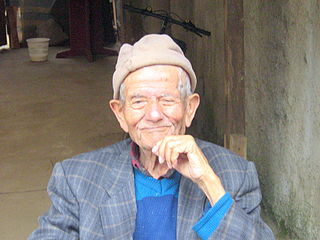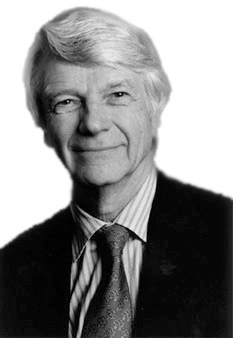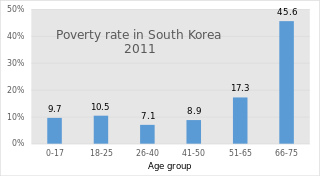Related Research Articles
Retirement is the withdrawal from one's position or occupation or from one's active working life. A person may also semi-retire by reducing work hours or workload.

A pension is a fund into which amounts are paid regularly during the individual's working career, and from which periodic payments are made to support the person's retirement from work. A pension may be:

Old age is the range of ages for persons nearing and surpassing life expectancy. People of old age are also referred to as: old people, elderly, elders, seniors, senior citizens, or older adults.
A nursing home is a facility for the residential care of older people, senior citizens, or disabled people. Nursing homes may also be referred to as care homes, skilled nursing facilities (SNF) or long-term care facilities. Often, these terms have slightly different meanings to indicate whether the institutions are public or private, and whether they provide mostly assisted living, or nursing care and emergency medical care. Nursing homes are used by people who do not need to be in a hospital, but cannot be cared for at home. The nursing home facility nurses have the responsibilities of caring for the patients' medical needs and also the responsibility of being in charge of other employees, depending on their ranks. Most nursing homes have nursing aides and skilled nurses on hand 24 hours a day.

The dependency ratio is an age-population ratio of those typically not in the labor force and those typically in the labor force. It is used to measure the pressure on the productive population.

Elderly care, or simply eldercare, serves the needs of old adults. It encompasses assisted living, adult daycare, long-term care, nursing homes, hospice care, and home care.

Sexuality in older age concerns the sexual drive, sexual activity, interests, orientation, intimacy, self-esteem, behaviors, and overall sexuality of people in middle age and old age, and the social perceptions concerning sexuality in older age. Older people engage in a variety of sexual acts from time to time for a variety of reasons. Desire for intimacy does not disappear with age, yet there are many restrictions placed on the elderly preventing sexual expressions and discouraging the fulfillment of sexual needs. Sexuality in older age is often considered a taboo, yet it is considered to be quite a healthy practice; however, this stigma can affect how older individuals experience their sexuality. While the human body has some limits on the maximum age for reproduction, sexual activity can be performed or experienced well into the later years of life.
Social welfare, assistance for the ill or otherwise disabled and the old, has long been provided in Japan by both the government and private companies. Beginning in the 1920s, the Japanese government enacted a series of welfare programs, based mainly on European models, to provide medical care and financial support. During the post-war period, a comprehensive system of social security was gradually established.

The labor force in Japan numbered 65.9 million people in 2010, which was 59.6% of the population of 15 years old and older, and amongst them, 62.57 million people were employed, whereas 3.34 million people were unemployed which made the unemployment rate 5.1%. The structure of Japan's labor market experienced gradual change in the late 1980s and continued this trend throughout the 1990s. The structure of the labor market is affected by: 1) shrinking population, 2) replacement of postwar baby boom generation, 3) increasing numbers of women in the labor force, and 4) workers' rising education level. Also, an increase in the number of foreign nationals in the labor force is foreseen.
Financial gerontology is a multidisciplinary field of study encompassing both academic and professional education, that integrates research on aging and human development with the concerns of finance and business. Following from its roots in social gerontology, Financial gerontology is not simply the study of old people but emphasizes the multiple processes of aging. In particular, research and teaching in financial gerontology draws upon four kinds of aging or "'four lenses" through which aging and finance can be viewed: population aging, individual aging, family aging, and generational aging. While it is problematic that "demography is destiny," demographic concepts, issues, and data play a substantial role in understanding the dynamics of financial gerontology. For example, through the lens of population aging, demography identifies the number of persons of different ages in cities and countries—and at multiple points in time. Through the lens of individual aging, demography also notes changes in the length of time—number of years lived in older age, typically measured by increases in life expectancy. From in its founding years in the beginning of the 21st century, one primary interest of Financial Gerontology has been on baby boomers and their relationships with their parents. The impact of these two kinds of aging on finance are reasonably apparent. The large and increasing number of older persons [population aging] in a society, no matter how "old age" is defined, and the longer each of these persons lives [individual aging], the greater the impact on a society's pattern of retirement, public and private pension systems, health, health care, and the personal and societal financing of health care. The focus on boomers illustrates also the other two lenses or "kinds" of aging. How boomers deal with the social, emotional, and financial aspects of their parents' aging is a central aspect of family aging. And how boomers may differ from their parents born and raised twenty to forty years earlier, and differ from their Generation X and Millennial children and grandchildren, are substantial aspects of generational aging.

Many retirement issues for lesbian, gay, bisexual, transgender (LGBT) and intersex people are unique from their non-LGBTI counterparts and these populations often have to take extra steps addressing their employment, health, legal and housing concerns to ensure their needs are met. Throughout the United States, "2 million people age 50 and older identify as LGBT, and that number is expected to double by 2030", estimated in a study done by the Institute for Multigenerational Health at the University of Washington. In 1969, the Stonewall Riots marked the start of the modern gay rights movement and increasingly LGBTQ+ people have become more visible and accepted into mainstream cultures. LGBTQ+ elders and retirees are still considered a newer phenomenon creating challenges and opportunities as a range of aging issues are becoming more understood as those who live open lives redefine commonly held beliefs and as retirees newly come out of the closet.

Japan has the highest proportion of elderly citizens of any country in the world. 2023 estimates showed that about 43% of the Japanese population was above the age of 60, and 25.9% was above the age of 65, a figure that increased to 29.8% by 2022. By 2050, an estimated one-third of the population in Japan is expected to be 65 and older.

Active ageing is a concept recently deployed by the European Commission, the World Health Organization, and used also in Human Resource Management. This concept evokes the idea of longer activity, with a higher retirement age and working practices adapted to the age of the employee. It also extends to the social engagement of the elderly in the collectivity.

In Japan during the 1980s, the economy was in a boom where buyers found themselves paying the highest prices for goods and commodities. As of March 1980, the unemployment rate in Japan was 4.9%; a very low number compared to the unemployment rate during the height of the 1990s. The following decade would see Japan's economy decline substantially, giving rise to the name the Lost Decade.

Ageism is bias against, discrimination towards, or bullying towards individuals and groups on the basis of their age. The term was coined in 1969 by Robert Neil Butler to describe discrimination against the elderly, patterned on the terminology of sexism and racism. Butler defined ageism as a combination of three connected elements. Originally it was identified chiefly towards older people, old age, and the aging process; discriminatory practices against older people; and institutional practices and policies that perpetuate stereotypes about elderly people.
India operates a complex pension system. There are however three major pillars to the Indian pension system: the solidarity social assistance called the National Social Assistance Programme (NSAP) for the elderly poor, the civil servants pension and the mandatory defined contribution pension programs run by the Employees' Provident Fund Organisation of India for private sector employees and employees of state owned companies, and several voluntary plans.
Elder rights are the rights of older adults, who in various countries are not recognized as a constitutionally protected class, yet face discrimination across many aspects of society due to their age.

South Korea's pension scheme was introduced relatively recently, compared to other democratic nations. Half of the country's population aged 65 and over lives in relative poverty, or nearly four times the 13% average for member countries of the Organisation for Economic Co-operation and Development (OECD). This makes old age poverty an urgent social problem. Public social spending by general government is half the OECD average, and is the lowest as a percentage of GDP among OECD member countries.

In South Korea, aging refers to an increase in the proportion of senior citizens to the total population. The term "senior citizens" include those aged 65 or older. According to Article 3 no.1 of the Framework Act on Low Birthrate of an Aging Society, the term "aging population" refers to the increasing proportion of elderly people in the entire population.
South Korea introduced its Basic Old-Age Pension in 2008 as part of its pension system. According to the Ministry of Health, Welfare and Family Affairs, the Basic Old-Age Pension is "designed to enhance welfare of the elderly by providing a monthly pension payment to the elderly in need." The pension was intended to benefit workers contributing to the National Pension Scheme.
References
- ↑ "Praying for a 'pokkuri' moment: No muss, no fuss". Japan Today. Retrieved 13 January 2017.
- 1 2 Inger, Maleen B. (2014). "Aging in Urban Japan - Intergenerational Reading in Tokyo". Working with Older People. 18 (1): 24–29. doi:10.1108/WWOP-10-2013-0026.
- ↑ McCurry, Justin (2015). "Japan Will be Model for Future Super-Ageing Societies". The Lancet. 386 (10003): 1523. doi: 10.1016/S0140-6736(15)00525-5 . PMID 26530607.
- 1 2 3 4 Kingston, Jeff (2011). Contemporary Japan: History, Politics And Social Change Since the 1980s (1st ed.). Wiley-Blackwell Publishing. p. 43. ISBN 978-1-4051-9194-4.
- ↑ Japan is running out of people to take care of the elderly, so it's making robots instead, Business Insider, 20 November 2015
- ↑ Martine, Julien; Jaussaud, Jacques (2018). "Prolonging working life in Japan: Issues and practices for elderly employment in an aging society". Contemporary Japan. 30 (2): 227–242. doi:10.1080/18692729.2018.1504530. S2CID 169746160.
 This article incorporates text from this source, which is in the public domain . Country Studies. Federal Research Division. - Japan
This article incorporates text from this source, which is in the public domain . Country Studies. Federal Research Division. - Japan